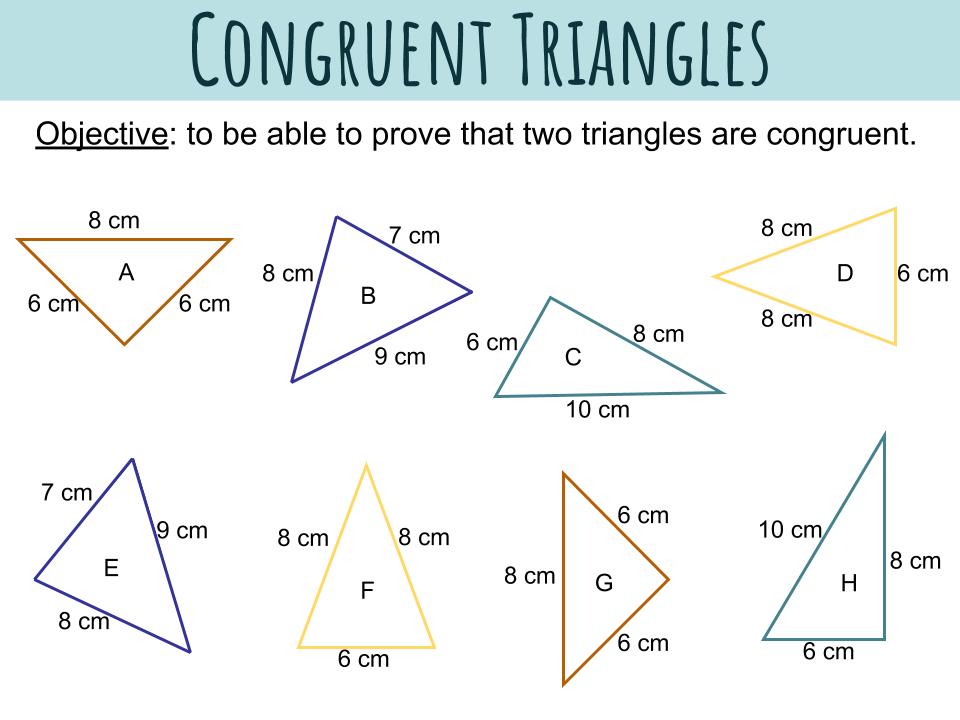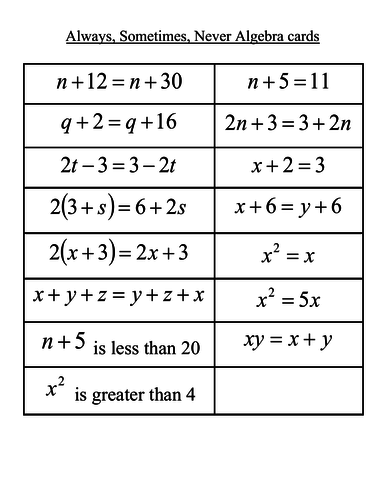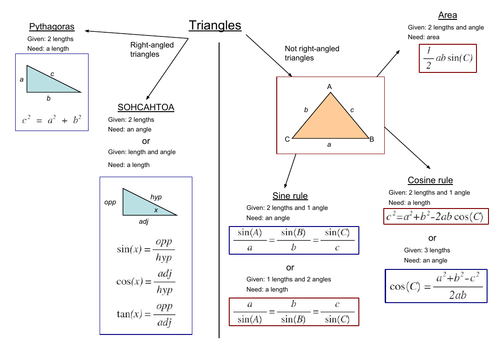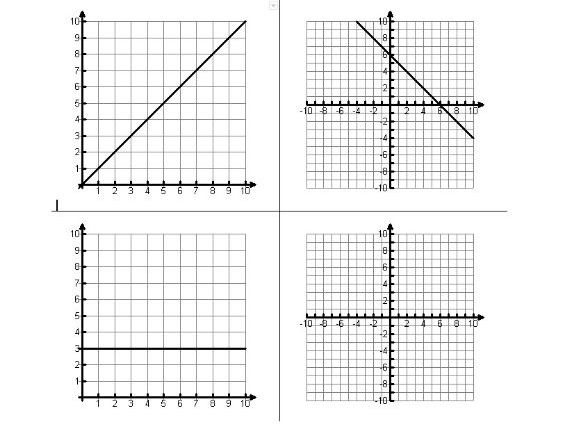
18Uploads
24k+Views
13k+Downloads
All resources

Congruent Triangles
A short PowerPoint presentation showing how to prove that two triangles are congruent.

Always, Sometimes, Never Algebra cards
A set of 15 Algebra cards that students can sort into; Always true, Sometime true and Never true.
I usually get them to stick their cards onto a poster and annotate each one with specific examples of when they are true and when they are not.
I have used as a GCSE revision activity but works equally well with KS3 as long as they have covered topics such as linear equations, expanding brackets and square numbers.

Linear and Quadratic Graph match up activity
A match up activity with a selection of 8 linear and quadratic (1 simple cubic) equations to match up with graphs. Two of the graphs are blank for students to sketch the graphs themselves. I have used this as a GCSE revision activity.

Multiplying and dividing by decimals follow me cards
A set of 28 follow me cards on multiplying and dividing by 0.1 and 0.01

Ordering decimal numbers
Here are some resources I have used to teach decimal numbers at KS2/KS3 (level 4).
The zip file contains:
A PowerPoint(pptx) presentation (2 different backgrounds provided) containing a short starter with 10 questions on which decimal number is largest.
A double sided A4 worksheet(docx/pdf) with 11 Questions about decimals on number lines. It includes questions about labelling decimals on number lines and using number lines to add decimals together. It looks at numbers to 1 and 2 decimal places.
A card sorting activity (docx/pdf) with 8 decimal numbers that students need to put into order. There are 8 different sets of numbers so once they have ordered one set they can swap with someone else and try a different set. The sets of 8 numbers go up to 3 decimal places and are designed to challenge common misconceptions.

Negative Numbers
A selection of resources about negative numbers for KS3
The zip file contains:
A PowerPoint (pptx) presentation introducing negative numbers using some temperatures on a map of the British Isles.
A worksheet (pdf) that has another map of the British Isles and students are asked to create their own worded questions involving negative numbers.
A worksheet(pdf) used as a starter with a variety of scales that students fill in missing numbers for.
A worksheet(pdf/docx) on adding and subtracting negative numbers with answers.
A worksheet(pdf/docx) on multiplying and dividing negative numbers with answers.

Percentages revision sheet
An A5 revision sheet showing how to calculate a percentage of an amount, express one quantity as a percentage of another and work out a percentage increase/decrease.

Revision sheet showing formula for triangles
A revision sheet showing formula for pythagoras, SOHCAHTOA, sine and cosine rules

Triangles reasoning starter
This can be used as a starter activity where students simply count how many triangles they can see.
It can also be used as a longer activity where you give each student the worksheet containing 8 blank diagrams and they can shade on how many triangles they can see. They can also name the triangles and label properties of the shapes, such as equal sides or right angles.
Finally it can be used as an investigation where you ask students to justify how they know what type of triangle it is using the properties of the shape. They can also discuss lines of symmetry and calculate the area of some of the triangles.

Data collection and types of data
A unit of work to introduce types of data and to discuss different ways of collecting data.
The zip file contains:
A PowerPoint (pptx) slide on two-way tables used as a lesson starter.
A PowerPoint (pptx) presentation that asks questions about types of data (primary/secondary, qualitative/quantitative) and data collection techniques including types of sampling. It also briefly looks at how different types of data can be represented in bar charts, frequency diagrams and histograms.
A worksheet (pdf/docx) on collecting data where students match types of data to keywords such as primary, secondary, qualitative, quantitative, discrete and continuous.
A Match-up activity (pdf/docx) on sampling methods, where students match the method with its description and some advantages and disadvantages of the technique. Includes an answer sheet.
A worksheet (pdf/docx) about surveys showing 7 different survey questions. Students are asked for one criticism of each question and to rewrite it in a more suitable form.
A worksheet (pdf/docx) about representing data containing 5 questions. Each question has a table containing data and students are asked to draw 2 bar charts, a pie chart, a line graph and a scatter graph. This is a good revision exercise to remind students of the variety of graphs they already know how to draw.

Stem and Leaf diagrams
The zip file contains:
A PowerPoint presentation (pptx) on stem and leaf diagrams. It shows how to draw a stem and leaf diagram from a set of unordered data and find the median. It also shows 2 other sets of data and asks students what questions they might be asked about this data.
A worksheet (pdf/docx) to go with the presentation with 2 sets of data. One is raw data and one is in the form of a stem and leaf diagram. Students are asked to think up their own questions about the data.

Quadratic Sequence Examples
Two examples of how to find the formula for a quadratic sequence by solving simultaneous equations.

Sequences investigation (using square and hexagonal tile patterns)
There are 2 simple sequence investigations, one using square tiles and one using hexagonal tiles. Each investigation has an A4 worksheet to set out the problem and a PowerPoint presentation to go through the solution.
There are also 2 extension investigations that involve square and triangular numbers. The method of using simultaneous equations to find a quadratic formula is shown in the accompanying Powerpoint along with a more visual approach.
These investigations can also be used as examples after which you may ask students to create their own patterns with square/hexagonal tiles and find solutions to their own questions. To help students do this there is a sheet of other hexagonal tile sequences to give them some ideas.

Linear graphs match up activity
A match up activity for KS3 Mathematics. Students need to match up simple linear graphs with their equations, possible co-ordinates and tables of values. Some of the graphs and tables are left blank for students to fill in themselves. One of the graphs requires students to make up their own equation for a straight line and draw it.
Examples of equations include; y=3, y=-x and y=3x+2.
Materials included: 5 linear graphs and 3 blank axis, 8 tables of values with some missing values, 7 equations and 1 blank equation, 7 possible co-ordinates and 1 blank co-ordinate. There is also a copy of the graphs matched with their equations to provide some answers if needed.

Averages for grouped data
The zip files contains the following:
A PowerPoint presentation with 3 exam style questions on finding averages from grouped data. Each question is completed incorrectly on the first slide in order to discuss common misconceptions and then the correct answer is worked through on the following slide (pptx).
A small starter activity looking at different ways continuous data can be grouped (pdf).
A worksheet on finding median values from grouped frequency tables with an answer sheet (pdf and docx).
A worksheet on finding the estimated mean from discrete grouped data (pdf and docx).
A collection of 8 exam style questions on finding averages from both discrete and continuous data. This can be used as another worksheet or the students can be split into groups and each group given a pair of questions to work through (pdf).


















